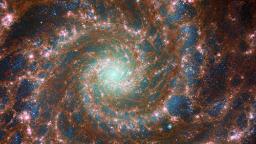
The “Cosmic Cliffs” are the edge of a nearby, young, star-forming region called NGC 3324 in the Carina Nebula. This was one of the first batch of images released by NASA from the James Webb Space Telescope in July. The telescope’s infrared view reveals previously invisible areas of star birth.
The telescope’s images of Jupiter were so spectacular, they surprised NASA’s scientists who were in awe of the rainbow auroras, giant storms and far-off galaxies on display.
The galaxy M74 shines at its brightest in this combined optical/mid-infrared image that features data from both the Hubble Space Telescope and the James Webb Space Telescope.
In this mosaic image stretching 340 light-years across, Webb’s Near-Infrared Camera (NIRCam) displays the Tarantula Nebula star-forming region in a new light.
Protostar L1527 is hidden in the neck of a dark, hourglass-shaped cloud of gas and dust.
Note:- (Not all news on the site expresses the point of view of the site, but we transmit this news automatically and translate it through programmatic technology on the site and not from a human editor. The content is auto-generated from a syndicated feed.))




I don’t think the title of your article matches the content lol. Just kidding, mainly because I had some doubts after reading the article. https://accounts.binance.com/en/register?ref=P9L9FQKY
I am a student of BAK College. The recent paper competition gave me a lot of headaches, and I checked a lot of information. Finally, after reading your article, it suddenly dawned on me that I can still have such an idea. grateful. But I still have some questions, hope you can help me.